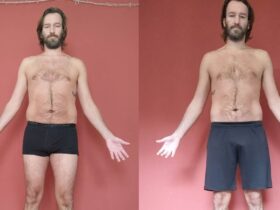Learn how to get shredded with the 5 rules of fat-burning cardio.
When embarking on a weight loss journey, individuals have a variety of approaches to choose from. The most effective strategy involves incorporating multiple methods, ranging from minor lifestyle adjustments to permanent changes in dietary habits. Several key strategies can aid in achieving weight loss goals:
- Create a Calorie Deficit: Weight loss necessitates consuming fewer calories than the body expends daily. To accomplish this, individuals can adopt a balanced, low-calorie diet while increasing their physical activity levels.
- Embrace a Healthy Diet: Prioritize whole, unprocessed foods such as fruits, vegetables, lean proteins, and whole grains. Conversely, avoid high-sugar, high-fat, and processed foods, as they can hinder weight loss efforts.
- Regular Exercise: Engaging in frequent exercise boosts calorie expenditure, aiding in weight loss and fat reduction. The more active one is, the more calories they burn, accelerating the weight loss process.
- Adequate Sleep: Sufficient sleep is crucial, as inadequate rest can disrupt hormone levels that regulate appetite and metabolism, potentially leading to weight gain. Aim for 7-8 hours of quality sleep per night.
- Stress Management: Stress can trigger overeating and contribute to weight gain. Adopt stress-reducing practices such as meditation, yoga, or deep breathing to support weight loss efforts.
Seeking support is another valuable approach. Enrolling in a weight loss program, seeking assistance from friends or family, or collaborating with a registered dietitian or personal trainer can provide accountability and guidance throughout the weight loss journey.
Now, let’s delve into the five specific rules for fat loss cardio as outlined by Dr Mike Israetel, an expert in Sport Physiology and the co-founder of Renaissance Periodization, a renowned YouTube channel focused on hypertrophy and muscle building. Dr Israetel’s insights will provide valuable guidance for those striving to achieve their weight loss goals through cardio exercises designed to burn fat effectively.
7 Best Low-Carb Breakfast Foods to Help Lose Fat
Get Shredded with the 5 Rules of Fat-Burning Cardio
When it comes to effectively using cardio for fat loss, there are five essential rules to consider, each contributing to a comprehensive and sustainable approach.
- Optimize SFR Modalities: Seek out cardio exercises that strike a balance between calorie-burning efficiency and minimal muscle fatigue and joint strain. High-calorie burning activities are beneficial, but overly taxing exercises can lead to sore muscles and potential joint issues. Finding the right mix of intensity and impact ensures you can perform cardio consistently without undue stress on your body.
- Emphasize Enjoyment: Consistency is the key to successful fat loss, and one way to maintain it is by choosing cardio modalities that you genuinely enjoy. Whether it’s swimming, cycling, running, or any other activity, doing what you love makes it easier to stay motivated and committed to your fat loss goals.
- Diversify Your Cardio Routine: Incorporating multiple cardio modalities into your weekly routine can enhance fat loss and prevent workout plateaus. By engaging in various activities such as swimming, biking, running, or cycling, you challenge different muscle groups and prevent overuse injuries.
- Recognize Cardio Limits: While cardio is beneficial for fat loss, excessive amounts can hinder progress. Overdoing cardio may lead to muscle loss and a decrease in metabolic rate, making it harder to shed fat. Combining cardio with strength training and proper nutrition ensures a more balanced and effective approach to fat loss.
- Consider Step Tracking: Monitoring your daily step count using a tracking device can help you stay active and maintain consistent progress. Striving for 10,000 steps daily is a reasonable target, as it promotes daily movement and contributes to overall fat burning.
The Literal Most Effective Exercise for Reducing Visceral Belly Fat
By adhering to these five rules, you can optimize your fat loss cardio strategy, fostering a sustainable and enjoyable routine that supports your weight loss goals effectively. Remember that combining cardio with a well-rounded fitness plan, healthy eating habits, and adequate rest is key to achieving long-term success in your fat loss journey.
Watch the video below to get a full grasp on Israetel’s take on how to get shredded with the 5 rules of fat-burning cardio.
Top 5 Best Foods to Lose Belly Fat
How to Increase Your Metabolism
5 Excellent Exercises to Promote Fat Loss
Learn More
The process of body recomposition typically involves the following key components:
- Resistance Training: Engaging in regular strength training exercises helps stimulate muscle growth and development. It involves performing exercises using weights, resistance bands, or bodyweight to challenge and overload the muscles, leading to hypertrophy (muscle growth) over time.
- Caloric Balance: Body recomposition requires paying attention to calorie intake and expenditure. To lose body fat while gaining muscle, you generally need to maintain a slight caloric deficit (consuming fewer calories than you burn) while ensuring an adequate intake of nutrients to support muscle growth and recovery.
- Protein Intake: Sufficient protein consumption is crucial for muscle building and repair. A higher protein intake helps support muscle protein synthesis and can aid in preserving lean muscle mass during the fat-loss phase.
- Cardiovascular Exercise: Incorporating cardio exercises, such as running, cycling, or swimming, can help increase calorie expenditure and support overall fat loss. However, it’s important to balance cardiovascular exercise with resistance training to ensure muscle preservation and growth.
- Progressive Overload: To continue making progress during body recomposition, it’s essential to progressively increase the intensity, volume, or resistance of your workouts over time. This progressive overload principle challenges your muscles and stimulates further growth.
It’s important to note that body recomposition is a gradual process that requires consistency, patience, and individual adjustments based on your body’s response. It may not happen as quickly as solely focusing on fat loss or muscle gain, but it can lead to long-term changes in body composition, overall strength, and aesthetics. Consulting with a qualified fitness professional or nutritionist can provide personalized guidance to help you achieve your body recomposition goals safely and effectively.
 Source: Dollar Gill on Unsplash
Source: Dollar Gill on UnsplashHow To Make The Biggest Visual Change To Your Body Quickly
How Many Calories Should You Eat to Lose Fat?
10 Proven Ways to Speed Up Fat Burning
Weight loss plateaus occur when a person’s weight loss progress slows down or stalls despite their continued efforts to lose weight. There are several reasons why this can happen:
- Metabolic adaptation: When you lose weight, your body adapts to the lower calorie intake and can start burning fewer calories at rest. This means that as you lose weight, your body requires fewer calories to maintain your new weight, which can cause your weight loss progress to slow down.
- Changes in physical activity: If you’ve been doing the same type and amount of exercise for a while, your body may become used to it and not burn as many calories as before. Additionally, you may experience fatigue or injury, which can cause you to decrease your physical activity level.
- Calorie intake: As you lose weight, you need fewer calories to maintain your weight. If you don’t adjust your calorie intake accordingly, you may start to consume too many calories, which can slow down or stall your weight loss progress.
- Hormonal changes: Hormonal changes, such as fluctuations in insulin levels, can affect weight loss progress. For example, insulin resistance can make it more difficult to lose weight, especially around the midsection.
- Psychological factors: Stress, lack of sleep, and other psychological factors can affect weight loss progress. Stress can increase levels of cortisol, which can promote fat storage, while lack of sleep can disrupt hormones that regulate appetite and metabolism.
To overcome weight loss plateaus, it’s important to reassess your diet, exercise routine, and lifestyle habits to identify areas where you can make adjustments. This can include increasing physical activity, adjusting calorie intake, and managing stress and sleep. Additionally, consulting with a healthcare professional or registered dietitian can provide personalized recommendations to help you reach your weight loss goals.
11 Golden Rules for Fat Loss from Thomas DeLauer
How Many Steps Should You Walk Every Day to Lose Fat?
Source link: https://www.boxrox.com/get-shredded-with-the-5-rules-of-fat-burning-cardio-2024/ by Robert Born at www.boxrox.com






